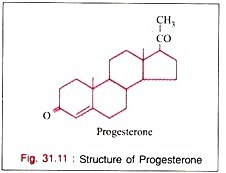ADVERTISEMENTS:
The following points highlight the two main types of female sex hormones. The types are: 1. Estrogens 2. Progesterone.
Female Sex Hormones Type # 1. Estrogens:
Chemistry:
a. The estrogens are C-18 steroids and differ from androgens in lacking the methyl group C10. The ring A is aromatic.
b. The androgens, testosterone, and androstenedione are precursors for the synthesis of the estrogens in testis, ovaries, adrenals and placenta.
The chemical structure of estrogen is given below:
Function:
1. Estrogens are responsible for the growth of the uterus, vagina, pelvis, breasts, pubic and axillary hair.
ADVERTISEMENTS:
b. They influence the menstrual cycle and are essential for breast development.
c. On administration, they promote mitotic activity in the uterine muscle and endometrium.
d. The vaginal epithelium is sensitive to the action of estrogen.
e. They influence the secretion of the gonadotrophs hormones in the anterior pituitary.
f. They increase the plasma levels of thyroxine and Cortisol binding globulins.
g. They cause rapid increase in RNA synthesis in uterine tissue.
h. They prevent lipid accumulation in liver when administered to animals having diets deficient in lipotropic factors i.e. methionine and choline.
i. They cause decrease in cholesterol level and other lipids in plasma. This is why the incidence of atherosclerosis is low in women as compared to men.
j. They regulate normal bone metabolism. Women after menopause develop osteoporosis.
ADVERTISEMENTS:
Normally the females excrete estrogens 5-100 Hg/24 hours in urine.
Female Sex Hormone Types # 2. Progesterone:
This hormone is formed in the corpus luteum of the ovary. It is also formed in the placenta during the latter part of pregnancy. It is secreted 1 or 2 days before ovulation takes place.
Chemistry:
a. It is synthesized from cholesterol.
ADVERTISEMENTS:
b. It is also formed in the adrenal cortex as a precursor of both C-19 and C-21 corticosteroids.
ADVERTISEMENTS:
The chemical structure is given below:
Functions:
ADVERTISEMENTS:
a. Progesterone causes the development of the endometrium preparing it for the implantation of fertilized ovum for conception.
b. It suppresses oestrus, ovulation and the production of luteinizing hormone. When pregnancy occurs, the ovulation and menstruation are suspended by the action of this hormone.
c. It stimulates the mammary glands.
d. It increases BMR during the luteal phase of normal menstrual cycle.
e. In the normal menstrual cycle, the anti-ovulatory effect of progesterone is the basis for the use of certain synthetic progestin’s as oral contraceptive agents.
ADVERTISEMENTS:
The normal level of progesterone in serum is 0.2-1.5 mg/ml.


